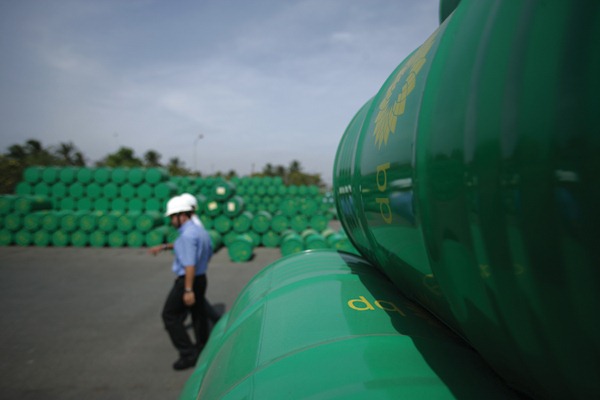Oil: an imperfect market
With much of Ireland’s energy needs still met by oil, leading energy economist Leo Drollas talks to Owen McQuade about the outlook for future prices.
“One of the myths of our business is that costs are behind high oil prices,” states Leo Drollas, who is the chief economist with the international think tank the Centre for Global Energy Studies (CGES).
“The financial industry often pushes this with its clients. Wall Street is saying: ‘The price of oil is high because costs are rising. It’s difficult to find oil, we are running out of oil’.” Drollas says that this is persuasive in that economic theory generally suggests that prices are driven by costs on the whole. The supply curve rises and meets the demand curve and that is what determines the price.
However, when Drollas details the actual production costs for a range of oil fields, as shown in the table, this is not the case. He accuses many analysts of “pumping up” these costs by adding in taxes and desired rates of return to justify high prices “as if it is a perfect market.”
“The oil market is not a perfectly competitive market. It has a cartel at its core. And once you have that going on, you break the link between marginal costs and prices,” he contends.
Drollas goes further: “Within its own context, it is dysfunctional because the OPEC cartel itself is not functioning properly. It is dominated by one producer which has, at the moment, 66 per cent of spare capacity, and at times they have had 75 per cent of global spare capacity (only OPEC has spare capacity).”
Effectively the last man in sets the market price “and the last man is a big dominant player. What they want the price to be bears no relation to what the costs are. It bears a strong correlation to their fiscal needs. So to have a worldwide industry based on the fiscal needs of one country of 25 million people, five million are foreign workers, is a very dangerous thing.”
Short-term prices
Drollas outlines the short term dynamics of the physical, or spot, oil market.
In the short term the physical price of oil, “the price of wet barrels,” is determined by stock disequilibrium. “This is the disequilibrium between the stocks people want to hold and the stocks they are actually holding. In practice it’s not the stocks themselves but the cover they provide: so many days cover,” explains Drollas. “You can translate this extra need for oil, or not, into so many barrels of oil needed from the residual supplier to the market, which is OPEC. And if the market is not getting these barrels from OPEC, the price tends to rise. If it is getting too much from OPEC, the price tends to fall.”
In addition to the physical market, there is a financial market which buys and sells oil futures. The physical market is linked to the financial futures market, through expectations of prices. The forward curve affects the spot price through ‘cash-and-carry’ hedging. For example, a refinery looks at the spot price and the future price and if the futures price is higher than the spot price that entices them to buy physical oil at the spot price and sell futures forward to lock in a margin. In the futures market, speculators can affect the futures prices through their buying and selling and the arbitrage from the cash-and-carry hedging translates this to the physical spot market.
With the volumes traded in the financial markets 20-30 times the amount traded in the physical market, the spot price is influenced heavily by the futures price through such a transmission mechanism. The WTI and Brent markets’ daily trading is close to 700 million barrels, which is 10 times the physical amount traded. Adding in other options and types of derivatives and swaps increases the volumes significantly.
Long-term drivers
Looking to the longer term, Drollas explains that this is the more difficult forecast although the drivers in theory should be easy to determine: “For the long-term price outlook you have to look at the fundamentals and look at the demand side for oil. You have also to look at the two components for the supply side: OPEC and non-OPEC, and the difference between these drive the price in the long term.”
In his view, the level of the long run price is the “philosophical question” worth asking but also very difficult to answer as “the long run is ultimately made up of infinitely small steps.” The Libya conflict and the Arab Spring were “not predicted five years ago, even one year ago” and that have changed the dynamics of the market. However, these short-term perturbations do even out in the longer term. The long-term trends based on GDP growth, population, the rise of China etc. “start to work and will give you some direction and that’s as good as it gets,” he predicts.
“One final fly in the ointment is technology. Technology can come in and change even the long run picture,” Drollas adds.
Shale gas, for example, has “dramatically changed the picture on gas” firstly in the United States where the technology was developed. Applying that technology to shale oil has released large deposits which were previously inaccessible “and that’s now transforming the US’ long-term decline in oil production.”
That trend, in turn, “offers the prospect of tens of billions of barrels of non-OPEC oil reserves.”
Drollas sums ups: “On the balance of probability there is more oil not less. Instead of being pessimistic about supply, history tells us you should be optimistic. The glass is half full not [half] empty.”
| Name | Location | $ per peak daily barrel | FBU Cost | Date |
|---|---|---|---|---|
| Haradh III project | Saudi Arabia | 2,500 | 1.3 | Producing |
| Khurais field | Saudi Arabia | 10,000 | 5.3 | Available |
| Jubarte (North Campos basin) | Brazil | 15,556 | 7.7 | 2015 |
| Chicontepec | Mexico | 15,000 | 9.2 | Ongoing |
| Manifa field | Saudi Arabia | 17,500 | 10.2 | 2013 |
| Jubilee field | Ghana | 17,875 | 10.4 | Producing |
| Hild offshore field | Norway | 27,686 | 16.0 | 2016 |
| Carabobo projects | Venezuela | 33,333 | 20.5 | 2011 |
| Heavy oil projects | Iran | 40,000 | 24.7 | 2015 |
| Laggan – Tormore | UK/Atlantic Ocean | 42,920 | 26.5 | 2014 |
| South Iolotan(phase 1) | Turkmenistan | 58,188 | 35.9 | Producing |
| Kashagan final | Kazakhstan | 85,000 | 40.0 | 2018 |






